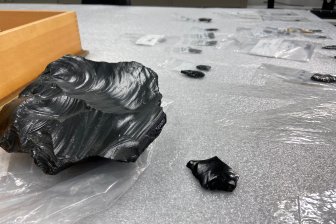Editor’s note: Some of the details in this article are disturbing. Read at your own discretion.

A grim end to the week for victims’ families sitting in on the James Smith Cree Nation coroner’s inquest as autopsy reports of their loved ones were read into evidence.
Bonnie Burns, Gregory Burns, Lydia-Gloria Burns, Christian Head, Lana Head, Damien Sanderson, Robert Sanderson, Carol Burns, Thomas Burns, Earl Burns, and Wesley Petterson were killed on the First Nation and in the community of Weldon in September 2022 at the hands of mass murderer Myles Sanderson.
An inquest into their deaths began on Jan. 15 and is wrapping up its second week.
Forensic pathologists Derek Musgrove and Shaun Ladham explained the cause of death of each victim over two days and disclosed their toxicology test results.
Victims sustained fatal blows to the neck, heart or head with a single-edged bladed object.
According to Musgrove, the deaths would have occurred between two and ten minutes of the attacks, making it difficult for Emergency Medical Services to perform life-saving measures.
“I would not say impossible, but it is highly improbable that they could have done that procedure in the field and saved the life.”
Musgrove said EMS would have had to distribute fluids to the victim, stop blood flow, and rush them to an emergency room for an immediate operation – a sequence of events likely to take considerably longer than 10 minutes.
Earl Burns was the only victim not found deceased at the same place he was attacked.
RCMP testified earlier in the inquest that after the attack on his family, Earl chased Myles away from his house in his school bus.
RCMP officers passed Earl’s bus crashed in the ditch several times but said they couldn’t stop because the massacre was unfolding too quickly.
When officers were able to respond to the scene later in the day, Earl was found dead in his bus.
“They could not have got there in time to save him,” Ladham said.
Unlike the other victims, Damien Sanderson — the brother of the killer — didn’t receive any blows to vital organs such as the neck or heart.
RCMP testified earlier in the inquest that Damien Sanderson was travelling in a van with his brother Myles when they got into a fight.
Musgrove explained that all of Damien’s wounds were on the left side of his body, consistent with RCMP’s testimony that he was in the passenger seat when Myles started stabbing him.
Without any injuries to vital organs, Musgrove said Damien could have lived for at least an hour after the attack before succumbing to blood loss.
RCMP found his body in a field next to a road near the First Nation.
Toxicology reports showed levels of various substances — ranging from alcohol to methamphetamine to cocaine to marijuana — in five of the victims’ bodies post-death.
James Smith Cree Nation member Darryl Burns, brother of Lydia-Gloria Burns, has noted the grip addictions and intergenerational trauma has on the community, hoping the inquest will bring about positive recommendations.
“We are doing a lot of things but not addressing the real issue,” Burns said at the start of the inquest. “We can prevent people from feeling that trauma and that pain and all of that anger in their hearts. Maybe another Myles will not be created again.”




Comments